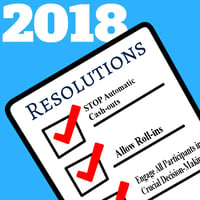 How are you hoping to improve yourself in 2018?
How are you hoping to improve yourself in 2018?
The most common New Year’s resolutions usually have to do with personal appearance, health, or behavior—losing weight, exercising more, dieting, quitting smoking, etc. Popular polls indicate that many of us are after a slimmer, fitter body for ourselves after each New Year’s Day.
Similarly, defined contribution plan sponsors are likely thinking about how they can make their plans more attractive and streamlined in 2018.
Here are three ways they can achieve this outcome:
- End Automatic Cash-Outs: Sponsors are permitted to automatically cash out accounts with less than $1,000 which have been left behind by former participants, and most do so—almost 90% of plan sponsors have a policy to cash out terminated-participant balances which are below $1,000, according to the latest Plan Sponsor Council of America (PSCA) annual survey of profit-sharing and 401(k) plans. However, doing so sends a very bad message, especially in a regulatory environment transformed by the Department of Labor’s Fiduciary Rule. Sponsors have an obligation as fiduciaries to make decisions that are in participants’ best interests, and automatically cashing out small, stranded accounts seriously harms the retirement prospects for the holders of those accounts—especially if their contact details are out-of-date, and as a result, they don’t receive the check or related notices in the mail.
Industry research indicates that, contrary to widely accepted opinion, participants do care about the small accounts they leave behind in former-employer plans. As documented in Boston Research Technologies CEO Warren Cormier’s recently published white paper, “Making the Right Choice the Easiest Choice: Eliminating Friction and Leaks in America’s Defined Contribution System,” of the participants in a 401(k) plan with a large healthcare services provider who received a notice indicating they could have their safe harbor IRA rolled into their active accounts in the plan, 91% gave their consent to the roll-in and transported their savings to their active accounts, paying a small fee to do so. In fact, over half of the accounts rolled in were less than $1,000. These rolled-in IRA accounts were originally funded through a mandatory distribution from a former-employer plan, rather than automatically cashed out by the healthcare services provider’s plan. The study demonstrates that, when given an easy way to do so, participants would prefer to keep these balances in the retirement system moving forward with them as they change jobs.
- Offer Roll-Ins as Part of a Financial Wellness Program: With industry research showing a pent-up demand among participants for a comprehensive roll-in solution for their small accounts, sponsors should fulfill their fiduciary duty by offering consolidation/roll-in assistance as part of their financial wellness programs. And if they don’t have a financial wellness program, they should set one up, and make roll-ins the first service they introduce as part of that initiative.
Thankfully, this New Year’s resolution is among the easiest to implement. According to the PSCA annual survey referenced earlier, 97.2% of defined contribution plans already allow roll-ins from other plans.
The vast majority of sponsors don’t have to make any changes to their plans in order to offer roll-in assistance. All they have to do is actively promote their plans as desirable destinations for consolidated retirement savings—calling attention to the investment options and other benefits that they and their record-keepers can provide participants.
Financial wellness is tough to measure, but the results of a roll-in program are easy to quantify—and use as a concrete metric to play up the performance and health of a plan for participants and the retirement services industry. Sponsors that need help with processing and managing roll-ins, or wish to improve their roll-in program results, can engage a roll-in service provider.
- Engage All Participants on Crucial Decision-Making: While companies are generally more enthusiastic about new hires than employees who are on their way out, as sponsors, they have a fiduciary duty to both. The DOL Fiduciary Rule has created a great deal of uncertainty among plan sponsors, providers, and participants at a time when, more than ever, hardworking Americans need non-conflicted, unbiased help managing and consolidating their retirement savings.
Establishing a call center, or utilizing a call center offered by a retirement savings portability service provider, to act as a resource where new and about-to-exit participants can ask questions and receive guidance about moving their 401(k) savings accounts forward can be very effective. This way, sponsors have an infrastructure in place to counsel new hires, and employees who are leaving, at the moment when they are making crucial decisions about their retirement savings.
There is always room for improvement, as the old saying goes. This is true for individuals as well as plan sponsors—and the above New Year’s resolutions can help sponsors make 2018 a year of significant improvement for their plans.
